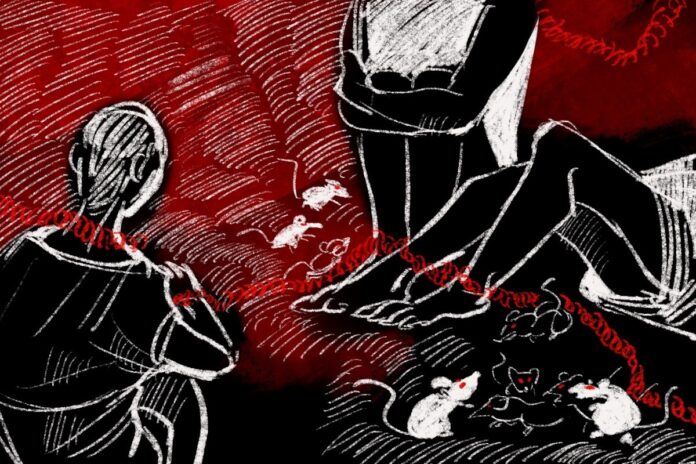WARNING: This article contains graphic descriptions some readers may find disturbing. Those in need of support can contact the Mental Health Crisis Line: 613-722-6914 (within Ottawa) and 1-866-996-0991 (outside Ottawa), the Ottawa Distress Centre Crisis Line: 613-238-3311, or the Youth Services Bureau 24/7 Crisis Line: 613-260-2360 or 1-877-377-7775 (toll).
June 10, 1692
Struggling through the crowd of restless men, women and children, Eleanor made her way to the large tree. Standing atop Gallows Hill, the young healer watched her closest friend, Bridget Bishop, hang. As Bridget’s lifeless body convulsed with the final spasms of death, Eleanor turned and walked away.
Over the coming months, Eleanor watched ten more witches hang. Every day, the unmarried healer saw her image grow increasingly tarnished. Rumours flew fast in Salem; some claimed she was a witch, others a murderer. She knew her days were numbered.
September 22, 1692
The cool morning breeze swept through the small kitchen, the fire trembling slightly as the gust of air reached it. A voice sliced through the thick fog outside and reached the healer through the open window. She knew to whom it belonged and dreaded it each morning. She knew what news it carried. The town crier announced eight witches would be hung that day. Among them was Eleanor.
“Hear Ye, Hear Ye! The Magistrates demand Eleanor Moore be presented before them! Eleanor Moore is accused of witchcraft!” Exclaimed the crier.
Eleanor paled, suddenly aware of the gazes on her small home and the two men closely following the town crier. She turned, tripping over the uneven surface of her kitchen floor as she hastily made her way toward the back door.
Her boots sank lightly into the muddy garden path, and she started running.
The cool morning breeze carried a voice to her ears. Charlotte. She turned, and a second voice soon joined the first.
“Eleanor! Come back! They’ll have your head!” Edith called, pleading eyes welling with tears.
Eleanor froze and turned, seeing tears stream down the girl’s small faces. The two men hurried over, reaching for her, roughly grabbing her arms. Elanor’s body fell back into the muddy garden soil. The men harshly lifted her by her arms and carried her out of the garden, but Eleanor’s eyes never once left her younger sister Edith.
“Be safe—” Eleanor said to her younger siblings. She wished to say more but was the men wouldn’t allow her to speak.
October 4, 1692
The cool, damp surface below Eleanor did nothing to ease the bone-chilling cold that tumbled down in waves from the barred windows and crawled onto her shivering body. Rats were scurrying between cells. Chains rattled as prisoners shook them to keep the rodents off their bodies. Daybreak brought little relief—the sun seeping in seemed to magnify the putrid stench of the cells. Meals were brought in twice a day: a tasteless and sometimes moldy mush.
Eleanor’s dress was still muddied from the day she was taken and no longer provided any warmth to her. Her tangled mane harboured lice and her ankles bore bruises from the restraints she was held in. In two days’ time, she would stand trial for her crimes.
October 6, 1692
A man dragged Eleanor into the small, dusty courtroom and placed her violently in front of the magistrates. The cold, frail woman shook, her restraints clanging in the silent room.
“The woman before you is accused of witchcraft. Eleanor Moore is a healer who had not attended church in nearly a week at the time of her arrest!” The man standing behind her spoke, giving the magistrates an overview of her case.
“What have you to say for yourself?” The head magistrate paused and allowed Eleanor a moment for her defense.
Eleanor lifted her head, but before she could open her mouth to speak, a voice came from the back of the crowded room. A short, plump woman stood up.
“She’s a witch! She killed my baby! Hang her!” The woman’s shrill voice echoed through the courtroom.
Suddenly, anyone who had suffered a loss, miscarried or been struck with any affliction accused Eleanor of being a witch. Some townsfolk began accusing her of the murder of her father and brother. The magistrate’s voice came booming through the courtroom once more.
“Silence!”
The loud voices dissipated until they were nothing more than a few fleeting whispers and the Magistrate resumed.
“Miss Moore, do you have a defense? Perhaps your husband could testify and exonerate you?”
She paused. She knew speaking would only worsen her situation, but so would silence.
“I don’t have a husband,” she mumbled, knowing the words would mark her demise.
“The girl before us is an unwed non-religious healer. The accusations brought against her are clearly founded. Death follows this girl. She must hang!” The magistrate spoke calmly, condemning the young woman to death.
Eleanor was roughly hauled back to her cell, knowing she would live out the last of her days there.
October 11, 1692
Eleanor grew weaker by the day. Knowing her death was near, Eleanor stopped eating the putrid food, letting the rodents enjoy it instead. Her body grew weak, and she could do nothing but lay on the stone floor.
November 13, 1962
Four days before Eleanor’s execution was set to take place, her lifeless corpse was discovered, still shackled to the wall. When her body was moved, her final message was found, carved into the stone of her cell with a bone left from a previous occupant:
I am not a witch. I am a killer.
Eleanor Moore’s body became another skeleton in the shallow grave atop Gallows Hill, but the eerie message remained.
Feature graphic by Angel Xing





![Here’s how your favorite media platforms shape your world view without you realizing it Advertising revenue and subscriptions are the main source of income for news outlets. [Graphic by Sara Mizannojehdehi]](https://charlatan.ca/wp-content/uploads/2021/07/11BE7ADB-1CC8-46E8-ADB4-568B3C7F1265-218x150.jpeg)
